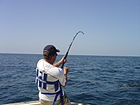| Revision as of 04:17, 14 January 2018 editInternetArchiveBot (talk | contribs)Bots, Pending changes reviewers5,387,806 edits Rescuing 0 sources and tagging 1 as dead. #IABot (v1.6.2) (Balon Greyjoy)← Previous edit | Revision as of 22:18, 29 January 2018 edit undoGreenC bot (talk | contribs)Bots2,564,227 editsm Rescued 1 archive link; reformat 1 link. Wayback Medic 2.1Next edit → | ||
| Line 8: | Line 8: | ||
| ==External links== | ==External links== | ||
| * |
* | ||
| {{angling topics|expanded=fly fishing}} | {{angling topics|expanded=fly fishing}} | ||
Revision as of 22:18, 29 January 2018
| This article relies largely or entirely on a single source. Relevant discussion may be found on the talk page. Please help improve this article by introducing citations to additional sources. Find sources: "Cosseboom" – news · newspapers · books · scholar · JSTOR (March 2017) |
Cosseboom is a type of artificial fly, commonly used in fly fishing to catch salmon. It was created by the American angler John C. Cosseboom of Woonsocket, Rhode Island in around 1923, for use on the Margaree River in Nova Scotia, Canada.
The Cosseboom was originally tied with an olive green body, silver tinsel ribbing, grey squirrel tail wing, and a lemon-yellow hackle tied as a collar after the wing was applied, with a red head. Other body and hackle color combinations have evolved, but all retain the grey squirrel tail wing. The Cosseboom remains a very popular and effective Atlantic salmon fly and is used worldwide.
Sources
- Atlantic Salmon Flies & Fishing, pp. 235–239, by Joseph D. Bates, Stackpole Books, Harrisburg, Pennsylvania, 1970.
External links
This fishing-related article is a stub. You can help Misplaced Pages by expanding it. |

